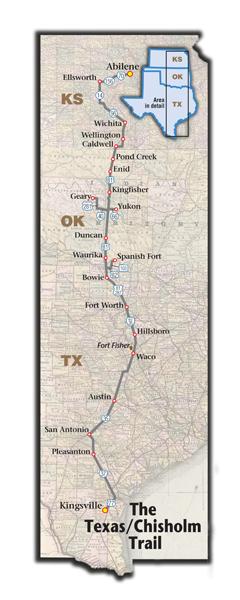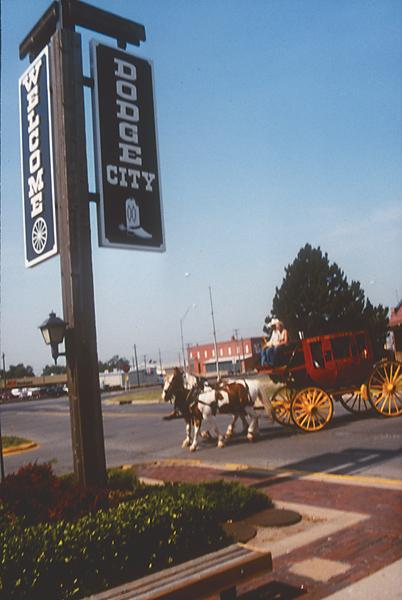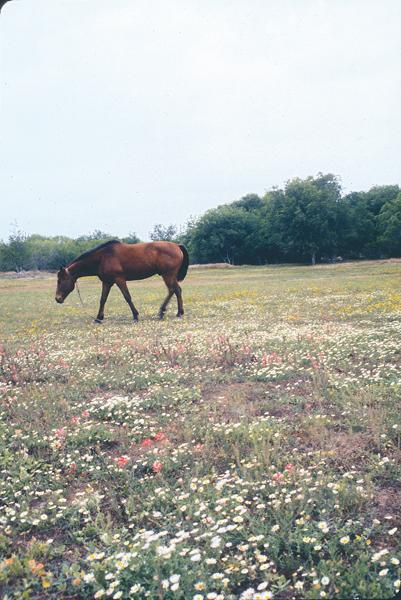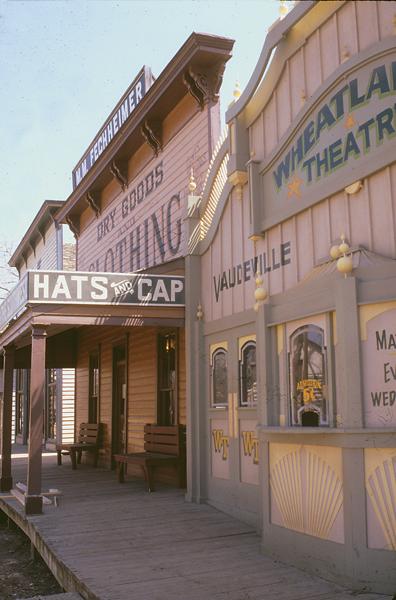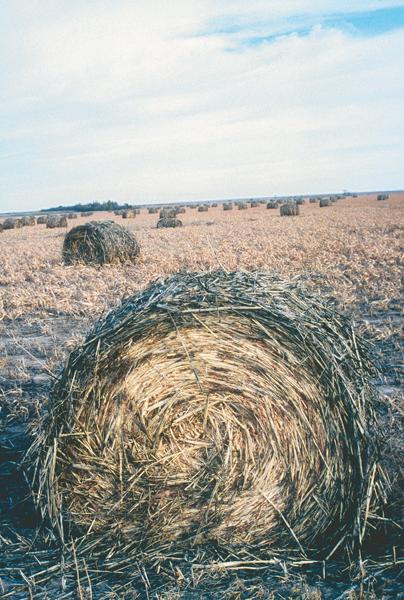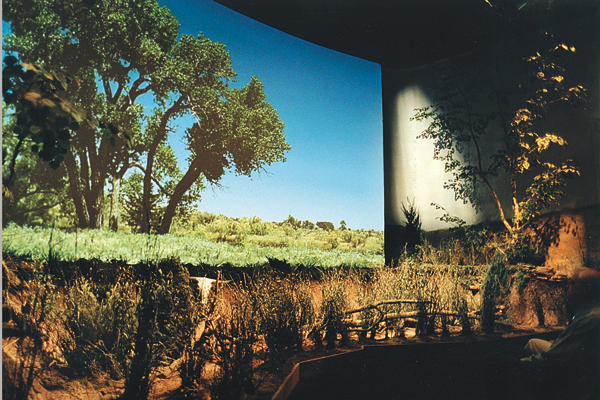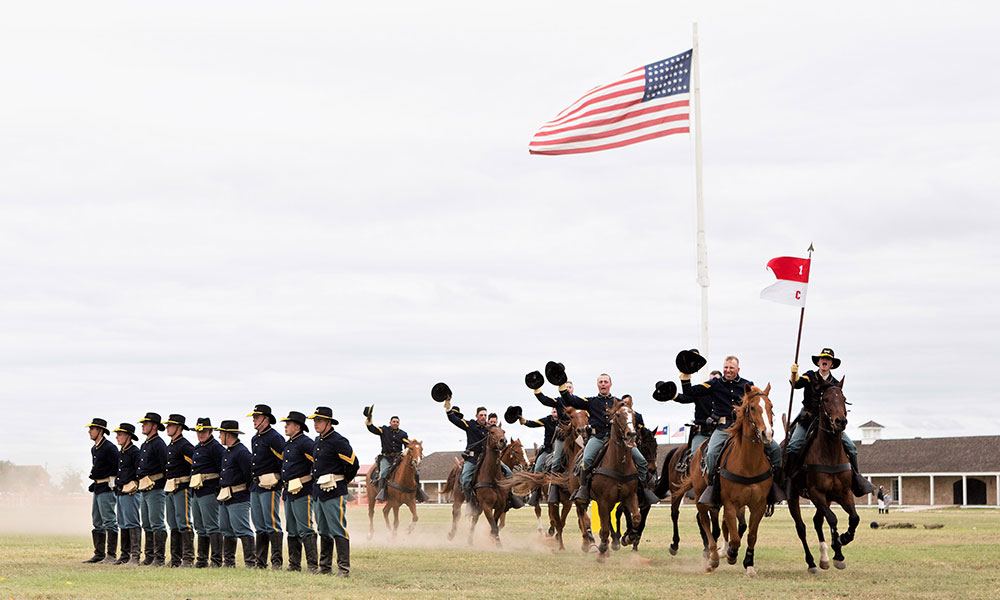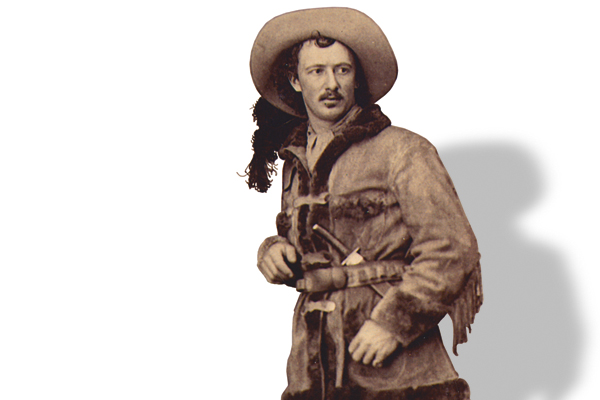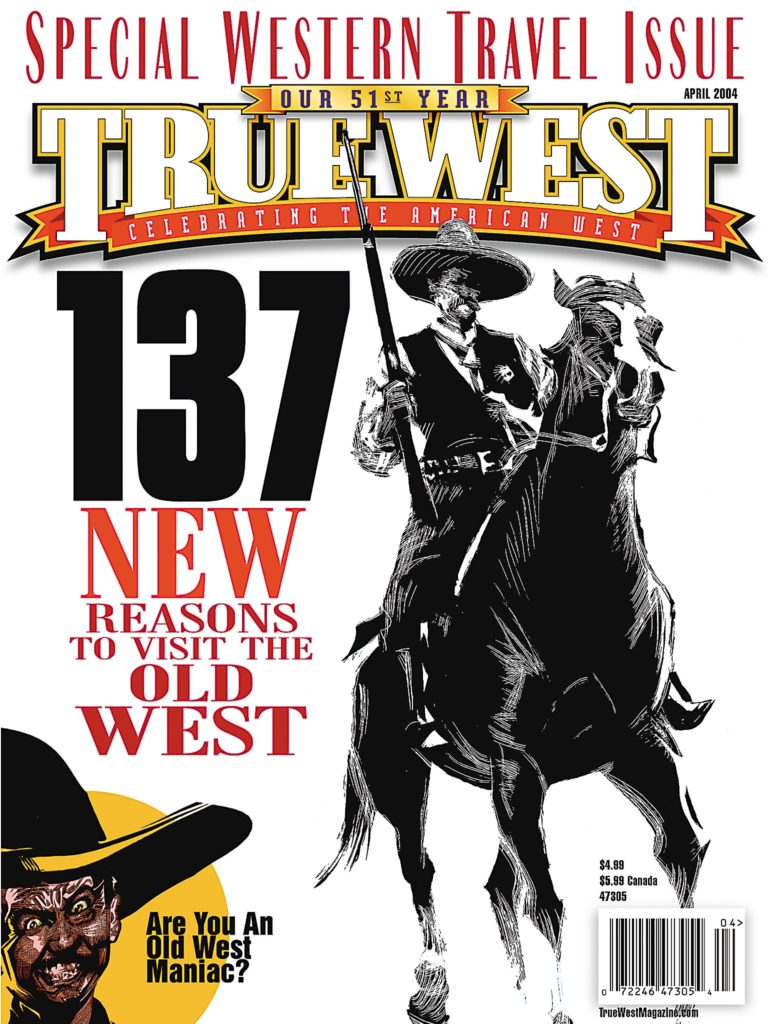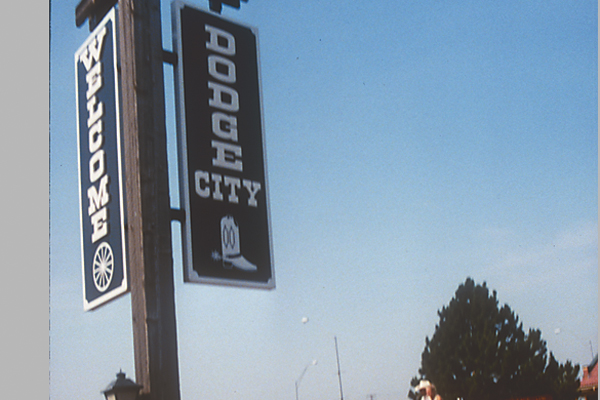 Jesse Chisholm was no cattleman, and the trail he blazed didn’t enter Texas but stretched from the Red River in present-day Oklahoma to Wichita, Kansas.
Jesse Chisholm was no cattleman, and the trail he blazed didn’t enter Texas but stretched from the Red River in present-day Oklahoma to Wichita, Kansas.
These days, however, the Chisholm Trail is synonymous with Texas, so I’m starting this drive way down south in Kingsville.
If you think I’m going to pass up Tex-Mex enchiladas, chicken-fried steaks and Shiner Bocks, you’ve got another think coming. I’m following the Texas/Chisholm cattle trail to Abilene, Kansas, which was the end of the trail for most drovers from 1867-71.
Cattle baron Richard King was among a group of Texas cattlemen who once envisioned a national cattle trail from South Texas to the shipping yards in Kansas. It didn’t come to pass, although trails sprouted up throughout Texas, heading to Missouri, Kansas and Nebraska. The Chisholm, of course, overshadows the Western and Sedalia Trails, and it’s easily followed.
The Texas Trail
Let’s point the herd north from Kingsville, where Capt. King bought 75,000 acres in 1853. When King died, he saddled his wife with $500,000 in debt, but the kineños (“King’s men”) working for the captain didn’t call Henrietta King “La Patrona” for nothing. She erased the debt and boosted the ranch holdings, which today encompass 825,000 acres, or 824,998.4 more than I own.
Still using the famous Running W brand, the ranch features a visitor center and offers special interest and nature tours. In town, you’ll find the King Ranch Museum and King Ranch Saddle Shop. What you won’t find in Kingsville is a decent steakhouse. When I ask a local to recommend a good steak or hamburger joint, Burger King is suggested. I pass on a Whopper and find a seafood restaurant instead.
From Kingsville, I head north on U.S. 77 to I-37 and begin a long, dreary, ugly drive toward San Antonio, stopping briefly in Pleasanton, the town that calls itself “Birthplace of the Cowboy,” before cruising into San Antonio to check out its cowpuncher heritage, of which there’s a lot.
First, there’s the Buckhorn Saloon and Museum (see Exhibiting the West, p. 92). Legend has it that Teddy Roosevelt recruited Rough Riders in this 1881-era bar (now a cafe) and Pancho Villa planned his revolution here—probably over Happy’s Pork Chops and a Lone Star Light.
Over on Broadway, the Texas Pioneer, Trail Drivers and Rangers Memorial Museum chronicles the history of, well, pioneers, trail drivers and Rangers. Captain King died at the nearby Menger Hotel, next door to the Alamo, in 1885.
From Alamo City, it’s north on I-35 to Austin. I wonder, did cowboys in 1868 blow their wages on Tecate and tattoos along Sixth Street? If punkers aren’t your cup of tea, check out the Driskill Hotel, which cattleman Jesse L. Driskill built in 1886. You probably won’t find cowboys at the Driskill, either, but you may find presidents, royalty and folks who remember former President Lyndon B. Johnson. This opulent estate is one of the “Leading Hotels of the World.”
After Austin, it’s on to Six-Shooter Junction, a trail stop known today as Waco. You have to feel sorry for this city on the Brazos River and all of its bad publicity: the Branch Davidian tragedy, a Baylor University basketball scandal surrounding Coach Dave Bliss and the university’s football team that couldn’t beat 11 True West staffers. Yet, this city has some bright spots.
My wife and I are serenaded—not mugged—when we stroll across the Waco Suspension Bridge. When it officially opened in 1870, it was one of the world’s longest single-span suspension bridges. Drovers had a much easier time crossing it than fording the often treacherous Brazos, although paying a toll for horses, riders and a trail herd probably was a mite costly. There’s no toll today, though, just pedestrians and a capella versions of Motown’s greatest hits.
There’s no singing, however, at the nearby Texas Ranger Hall of Fame & Museum at Fort Fisher, but don’t let that stop you. This is an outstanding collection of Ranger history, with one of the best exhibits of Old West guns this side of Wyoming’s Buffalo Bill Historical Center.
Cow Town rocks
Keep them dogies moving north to Hillsboro, then take I-35W to Fort Worth, which was, and always will be, “Cow Town.” It’s also the best stop on the ol’ C.T., and I’m not saying that because of a survey that found there was once a saloon for every 26 residents.
There’s almost always something going on in Cow Town, be it spring (Main Street Fort Worth Arts Festival), summer (Chisholm Trail Roundup), fall (Pioneer Days) or winter (Southwestern Exposition Live Stock Show and Rodeo).
Fort Worth is cowboy (Billy Bob’s Texas) and culture (Van Cliburn International Piano Competition). I first saw Don Edwards perform in the mid-1980s at the White Elephant Saloon, where the classic 1887 gunfight between saloon owner Luke Short and racketeer Jim Courtright is re-enacted each February. Other treasures include the Sid Richardson Collection of Western Art, the Cattle Raiser’s Museum and a myriad of shops and restaurants at Sundance Square and the Historic Stockyards. I hate to leave, but Abilene’s not getting any closer.
From Fort Worth, U.S. 81/287 follows the trail northwest and splits north on U.S. 81 at Bowie, home of the tiny Chisholm Trail Memorial Park (and not much else). Take U.S. 82 east to check out other trail stops, including Spanish Fort (north on Country Road 103), where bootmaker Joe Justin made a name for himself, and Saint Jo, where the Chisholm and California Road intersected. Or stay on 81, ford the Red River and feel that wind come sweepin’ off the plains.
In Old Oklahoma
My first stop is in Waurika at the Chisholm Trail Museum, a small but informative collection of dioramas and artifacts. In fact, Oklahoma’s chockful of C.T. museums. Just up the road in Duncan is the Chisholm Trail Heritage Center, which opened in 1998 and features an IMAX-style theater and a wealth of history. Yet another Chisholm Trail Museum rests in Kingfisher. On top of that, there are still the trail ruts at Monument Hill near Duncan, the watering hole (no, it’s not a bar) and monument at Yukon or all those historical markers along the highway.
Jesse Chisholm died on March 4, 1868, and was buried near present-day Geary. I attempt to visit his grave site, but one thing hasn’t changed since the days of the drovers; that unpredictable Oklahoma weather often tormented cowboys, and I find myself surrounded by floodwaters near Chisholm’s grave. So I give up and move north through Enid and Pond Creek, then cross the Kansas line and stop at “The Border Queen.”
The Kansas connection
Caldwell’s a lot friendlier than it was during its cow town heyday (1879-85). Former Billy the Kid pal Henry Brown pinned on the marshal’s badge for a while, but then he decided to rob the Medicine Lodge bank only to run afoul of vigilantes and buckshot.
Historical markers chronicle Caldwell’s Chisholm Trail history, and the town is small enough and fun enough to make a walking tour enjoyable.
A short ride north finds me in Wellington, home of another Chisholm Trail Museum, this one chronicling life in Sumner County in 40 rooms and 20,000 artifacts.
Of course, you can’t take the C.T. without stopping in Wichita, and you can’t stop in Wichita without visiting Old Cowtown Museum, a 17-acre living history museum (and sometimes movie set) that includes 35 exhibit areas. If you don’t like cowboys, fear not. This is Kansas (where cowboys weren’t always popular), so plenty of exhibits and artifacts pay tribute to the bane of a cowman’s existence: the sodbuster.
Don’t be misled, though, for Wichita—Kansas’ largest city—has much more to offer than Old Cow Town. The Wichita-Sedgwick County Historical Museum, the Indian Center Museum and the Wichita Zoo are first-rate, and Castle Inn Riverside, where I’ll hang my hat for a night, is superb.
Colonel Burton Harvey “Barbecue” Campbell, who ran roughshod over the cowboys at Texas’ XIT Ranch, wanted something fancy for his home, so he duplicated a Scottish castle that took two years to complete. Finished in 1888, the castle today is a popular bed and breakfast.
From Wichita, I drive on to Ellsworth. With the exception of Dodge City, Ellsworth probably does the most of any Kansas cattle town to promote its cowboy legacy.
While walking around Ellsworth, you may want to pay tribute to those 1870s cowboys by wearing the proper accouterments. Drovers Mercantile can rig you out from boots up, or you can drop next door at Johnny Bingo’s for a custom hat. Jim Gray, who founded Drovers Mercantile with Linda Kohls, is also championing another worthy Ellsworth cause. Gray is trying to develop the National Drovers Hall of Fame—yep, another C.T. museum—that will honor the men, women, horses, cattle, railroads and towns.
End of Trail
From Ellsworth, I hit I-70 and ease into Abilene, the cattle town that made cattle towns famous when Joseph McCoy persuaded railroad officials, Abilene businessmen and Texas trail bosses to ship cattle here.
Although former President Dwight D. Eisenhower draws more tourists than Wild Bill Hickok, Abilene supports cowboys better than it did in 1871, when officials told Hickok and Texans to take their business elsewhere. Drop in at the Dickinson County Historical Museum, or hit town for festivals such as Hickok Days (May), Wild Bill Hickok Rodeo (August) or Chisholm Trail Day Festival (October).
I’m hot, dirty and tired when I reach Abilene. Thinking about those drovers amazes me. They had enough energy to go drinking, gambling and consorting with lewd women after months in the saddle? Heck, I’m tuckered out after a week in an air-conditioned car.
Johnny D. Boggs traveled up and down the Chisholm Trail while researching his novel The Lonesome Chisholm Trail. Yet, Kansas, Oklahoma and Texas still let him come back.
Photo Gallery
How soon we saw it pass!
For our empire quickly crumbled
We had builded it on grass.”
The above excerpt from Edward Everett Dale’s poem, “An Empire of Grass,” comes to mind when viewing the ever diminishing hayfields in Western Kansas.
– All photos by Johnny D. Boggs –


